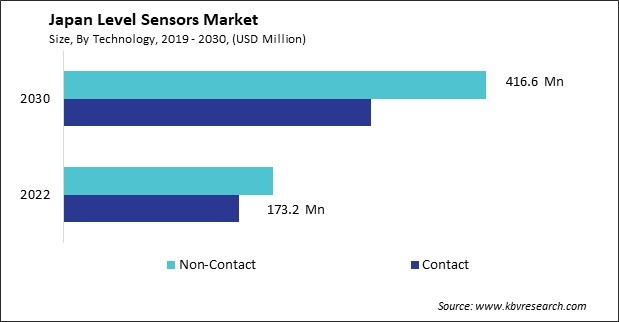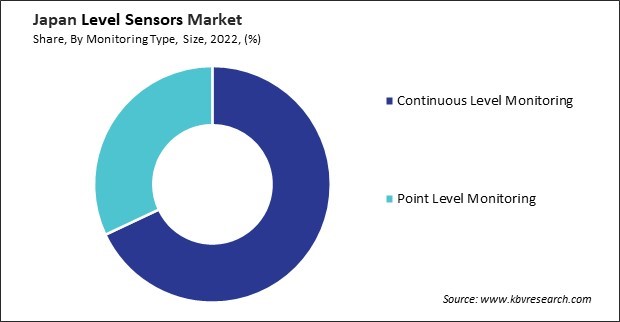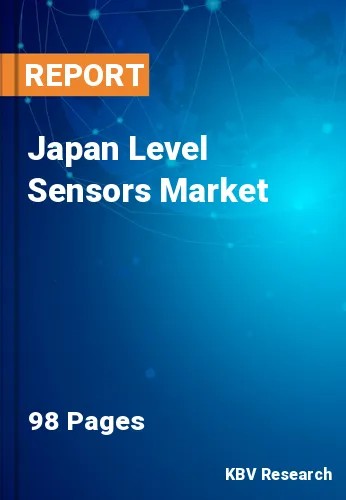The Japan Level Sensors Market size is expected to reach $719.6 Million by 2030, rising at a market growth of 8.4% CAGR during the forecast period. In the year 2022, the market attained a volume of 2,929.4 Thousand Units, experiencing a growth of 12.1% (2019-2022).
The level sensors market in Japan has witnessed significant growth in recent years. Japan, a technologically advanced country with a strong focus on innovation, has seen a rise in adopting advanced level sensing technologies. Capacitive, ultrasonic, and radar sensors are among the popular choices in the Japanese industry due to their accuracy, reliability, and ability to perform in diverse operating conditions. The automotive sector in Japan is also a significant consumer of level sensors, particularly for monitoring fuel levels in vehicles. With the increasing adoption of electric vehicles (EVs) and hybrid vehicles, the demand for level sensors for battery management systems has surged, presenting new opportunities for sensor manufacturers in the country.

Japan's aging population and increasing healthcare expenditure also present opportunities for the level sensors market. Level sensors are utilized in medical devices and equipment for applications such as patient monitoring, drug delivery systems, and diagnostic instruments. According to the International Trade Administration, the medical devices industry in Japan achieved a significant milestone in 2021, reaching a total value of $40 billion. As the healthcare industry continues to embrace digitalization and IoT technologies, there is a rising demand for smart and connected level sensing solutions that improve patient care, optimize resource utilization, and ensure regulatory compliance.
However, the COVID-19 pandemic has had a mixed impact on the level sensors market in Japan. While the initial phase of the pandemic led to disruptions in supply chains and temporary shutdowns of manufacturing facilities, the subsequent recovery and resurgence of industrial activities have driven the demand for level sensors. Moreover, the pandemic has underscored the importance of automation and remote monitoring capabilities, leading to increased investments in digitalization and sensor technologies.
The adoption of electric vehicles (EVs) is witnessing a significant surge in Japan, driving the demand for level sensors in various applications. As the world embraces sustainable transportation solutions, Japan, known for its technological advancements and commitment to environmental conservation, is at the forefront of this transition. One of the primary drivers behind the increasing adoption of EVs in Japan is the government's proactive policies and incentives to promote clean energy and reduce carbon emissions. The Japanese government has been encouraging consumers and manufacturers to transition towards electric vehicles through initiatives such as subsidies, tax incentives, and infrastructure development.
Moreover, Japanese automotive manufacturers have been investing heavily in the development of electric vehicles, aiming to capitalize on the growing global demand for eco-friendly transportation options. Companies like Toyota, Nissan, and Honda have been at the forefront of EV innovation, introducing new models with advanced battery technologies and efficient powertrains.
According to the Japan Automobile Dealers Association (JADA), sales of new electric vehicles in 2020 reached close to 1.4 million. The robust demand for hybrid electric vehicles (HEVs) in Japan has been evident since the introduction of the Toyota Prius in 1997, with HEVs claiming a staggering 97.8% share of the new electric vehicles sold in 2020. As these automakers ramp up their production of electric vehicles, the need for high-quality level sensors to monitor various parameters such as battery, coolant, and fuel levels becomes increasingly critical.
Furthermore, the growing awareness among consumers about the environmental benefits of electric vehicles is also contributing to their rising popularity in Japan. Therefore, the surge in electric vehicle adoption in Japan, propelled by government incentives, technological innovation, and environmental consciousness, underscores the critical demand for advanced-level sensors in sustainable transportation applications.
In Japan, a nation prone to natural disasters like earthquakes, tsunamis, and typhoons, disaster preparedness has become a paramount concern, catalyzing significant shifts in various industries, including the level sensors market. One of the primary drivers of this heightened focus on disaster preparedness in Japan's level sensors market is the government's proactive stance on disaster risk reduction and mitigation. As a result, businesses and organizations are increasingly investing in advanced technologies such as level sensors to fortify their infrastructure against potential disasters.
Furthermore, technological advancements in level sensing have led to the development of innovative solutions that offer enhanced accuracy, reliability, and remote monitoring capabilities. The Fukushima nuclear disaster in 2011 served as a wake-up call for Japan, highlighting the catastrophic consequences of inadequate disaster preparedness measures. Since then, there has been a concerted effort by public and private sectors to bolster resilience against future disasters, with level sensors emerging as integral components of comprehensive disaster risk management strategies.
Moreover, businesses' growing awareness of disasters' economic and social impacts has compelled them to prioritize risk management strategies. Level sensors play a critical role in disaster preparedness by providing real-time data on various parameters such as liquid levels, pressure, and temperature. They enable early detection of potential hazards and facilitate timely response and mitigation efforts. Therefore, Japan's heightened focus on disaster preparedness has driven significant investment and innovation in the level sensors market, positioning these technologies as essential components of comprehensive disaster risk management strategies.

The level sensors market in Japan is a crucial segment of the country's industrial landscape, supporting various sectors such as automotive manufacturing, electronics, chemicals, and food processing. One of the key players in the Japanese level sensors market is Omron Corporation, a multinational electronics company known for its automation and sensing technologies. Omron offers various level sensors, including ultrasonic, capacitive, and float-type sensors, designed for precise and reliable level detection in various industrial applications. The company's sensors are renowned for their accuracy, durability, and versatility, making them ideal for use in challenging environments across different industries.
Fujikura Ltd. is also a prominent player in the Japanese level sensors market, offering various innovative sensor solutions for industrial and automotive applications. The company's portfolio includes ultrasonic, capacitance, and optical level sensors, known for their high precision, durability, and resistance to harsh operating conditions. With a focus on research and development, Fujikura continues to introduce new sensor technologies to address emerging customer needs and industry trends.
Another significant player in the Japanese level sensors market is Panasonic Corporation, a leading electronics manufacturer with a diverse portfolio of products and solutions. Panasonic's level sensors utilize advanced technologies such as ultrasonic and optical sensing to provide accurate and real-time level measurements in liquids and solids. The company's sensors are widely used in industrial automation, food processing, and water management applications, where reliability and performance are paramount.
Mitsubishi Electric Corporation is also a significant player in the Japanese level sensors market, offering a diverse range of industrial automation and control sensor technologies. Mitsubishi Electric's portfolio includes ultrasonic, radar, and laser level sensors, designed to meet the stringent requirements of modern manufacturing and process industries. The company's sensors are known for their high accuracy, reliability, and durability, making them suitable for various applications.
In addition to these key players, several other companies contribute to the vibrant landscape of the Japanese level sensors market, including Keyence Corporation, Yokogawa Electric Corporation, and Hitachi, Ltd. These companies offer a wide range of sensor technologies and solutions tailored to specific industry needs, driving innovation and competitiveness in the industry. Hence, the level sensors market in Japan is characterized by intense competition, technological innovation, and a strong focus on meeting customer demands across various industries.
By Technology
By Monitoring Type
By End User
Our team of dedicated experts can provide you with attractive expansion opportunities for your business.

